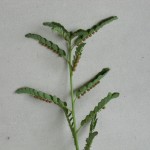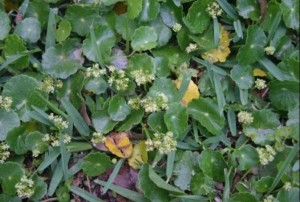Above average rainfall this summer has supplied water to more than just our landscapes, weeds are benefiting and flourishing as well.
Just as with any other landscape pest, proper weed control starts with accurate identification and knowledge about the life cycle of the weed.
When weeds are low in number, mechanical control (pulling, mowing) is a good start. If weed population continues to increase and herbicide options are considered, several questions need to be answered before product application.
Questions you need to ask yourself about your weed and site:
- What weed(s) are you trying to control?
o Be sure you know what the name of the weed is so that you can find it on your product label “weeds controlled” list; if you need help with identification contact your local county extension office - What is your site?
o Lawn – specific turfgrass is important, what is safe to use on one type may kill another
o Ornamental beds – again note specific plants near your treatment area in case of sensitivity
o Water bodies – some herbicides are not labeled for use within a given distance of water; if the weed is in or around the water only use herbicides listed for aquatic weed control - What is the life cycle of your weed?
o Annual – one season life cycle, summer annuals complete their life cycle between spring and fall; winter annuals are active between fall and spring
o Biennial – two growing season life cycle
o Perennial – plant lives for three or more years - What category does your weed fall into?
o Grasses – one seed leaf as it emerges from the soil; hollow, rounded, stems with nodes, parallel veins in true leaves; examples are crabgrass, dallisgrass, cogongrass, torpedograss
o Broadleaves – have two seed leaves and true leaves have net-like veins and usually have showy flowers; examples are lespedeza, dollarweed, clover, chickweed, henbit, florida betony
o Sedges/Rushes – sedges have solid triangular stems; rushes have round stems; both like moist or wet habitat; examples are purple nutsedge, yellow nutsedge, beak rush
Basic information about herbicide categories:
- Has the weed emerged (do you see it already?) or are you anticipating it because it was present in the past?
-
Post-emergence Herbicides – these products are for use on weeds that are already growing and are past emergence; they generally are most effective on young weeds that are actively growing; products are less effective on weeds that have already flowered or are stressed due to drought or recent mowing
- Pre-emergence Herbicides – must be applied before seed germination and require some pre-planning, if applied after weed emergence they will have little to no effect; for control of winter weeds apply when nighttime temperatures drop to 55-60⁰F for several consecutive days (~ early October for North Florida); for summer weeds watch for day temperatures to reach 65-70⁰ for 4-5 consecutive days (~ early March for North Florida), some summer weeds such as goosegrass and chamberbitter germinate later and require different timing, know your weed!
- What will the herbicide kill?
o Selective – controls certain plant species without seriously affecting growth of other plant types; for example broadleaf weed killer targets broadleaf plants, although they can still damage turfgrass if not used correctly, always follow the label
o Nonselective – will kill any green plants whether broadleaf, grass, sedge, or rush; as with any chemical follow all label directions - What part of the plant is killed?
o Contact – affects only the portion of the plant that it comes into contact with, they are not moved throughout the plant so they do not kill any underground plant parts such as rhizomes or tubers; many perennial weeds are able to regrow from their underground parts, so contact herbicides give only temporary results
o Systemic – the chemical is translocated in the plant’s vascular system; systemic herbicides take longer to show an effect than contact, but will kill more than just the visible leaves and stems - As with any other pest management plan, always keep records to include at a minimum:
• Site description
• Pest information
• Control actions taken and success of each method -
Good recordkeeping will increase your likelihood of success in your fight against weeds!
For more information read EDIS Publication “Weed Management in Home Lawns”
Latest posts by Julie McConnell (see all)
- Thinking of Starting a Cut Flower Business? Don’t miss out on Cut Flower 101! - October 30, 2025
- 2025 Gardening in the Panhandle LIVE! Great Southeast Pollinator Census – Bee a Citizen Scientist! Wrap Up - September 18, 2025
- Will you Bee a Citizen Scientist? - August 15, 2025


